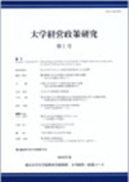8 巻
選択された号の論文の12件中1~12を表示しています
- |<
- <
- 1
- >
- >|
論文
-
2018 年 8 巻 p. 1-18
発行日: 2018年
公開日: 2022/04/28
PDF形式でダウンロード (430K) -
2018 年 8 巻 p. 19-36
発行日: 2018年
公開日: 2022/04/28
PDF形式でダウンロード (310K) -
2018 年 8 巻 p. 37-53
発行日: 2018年
公開日: 2022/04/28
PDF形式でダウンロード (275K) -
2018 年 8 巻 p. 75-91
発行日: 2018年
公開日: 2022/04/28
PDF形式でダウンロード (372K)
研究ノート
-
2018 年 8 巻 p. 95-111
発行日: 2018年
公開日: 2022/04/28
PDF形式でダウンロード (314K) -
2018 年 8 巻 p. 113-129
発行日: 2018年
公開日: 2022/04/28
PDF形式でダウンロード (311K)
資料
-
2018 年 8 巻 p. 133-149
発行日: 2018年
公開日: 2022/04/28
PDF形式でダウンロード (306K) -
2018 年 8 巻 p. 151-166
発行日: 2018年
公開日: 2022/04/28
PDF形式でダウンロード (384K) -
2018 年 8 巻 p. 167-182
発行日: 2018年
公開日: 2022/04/28
PDF形式でダウンロード (1487K) -
2018 年 8 巻 p. 183-198
発行日: 2018年
公開日: 2022/04/28
PDF形式でダウンロード (291K) -
2018 年 8 巻 p. 199-215
発行日: 2018年
公開日: 2022/04/28
PDF形式でダウンロード (362K) -
2018 年 8 巻 p. 217-230
発行日: 2018年
公開日: 2022/04/28
PDF形式でダウンロード (334K)
- |<
- <
- 1
- >
- >|
